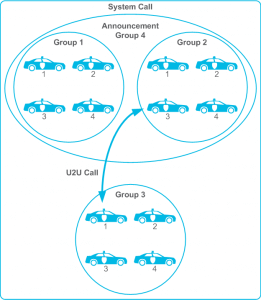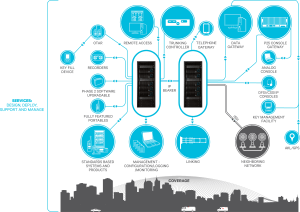Introduction to P25
P25 Network Architecture
P25 Network Management
This section looks at three aspects of network management.
- Tactical management, the management of subscribers and groups using the network.
- Technical management, the configuration of network hardware.
And,
- Network monitoring, fault and performance information.
Let’s assume that we’re referring to a trunked P25 network. On a small network, these tasks may be carried out by the same person, while, on a larger network, different teams may look after each aspect.
So firstly, tactical management. In a trunked system, a mobile or portable radio is called a subscriber unit. In order for a subscriber unit to gain service on the network, it must be declared as a valid unit to the trunked system. Talk groups are the various teams that use the network, and the sites that permit it to use must also be declared to the trunked system.
When a network is designed, it will be designed to handle a certain number of calls and provide coverage over a specified area. The initial fleet of subscriber units and groups is declared to the system, and they can begin using the network. Over time, additional units and groups may be added to the network, or units may be deleted if they are lost or damaged. It is also possible to temporarily remove units for maintenance, or if they’re moved from one vehicle to another.
On many P25 networks, this type of tactical management of units and groups is carried out from a web browser connected to the RFSS.
On networks shared by many agencies, it is possible to restrict the tactical management login to a subset of the units on the system, so an agency can manage the radios that belong to them, but not touch radios belonging to other agencies.
On larger statewide networks, individual agencies may not carry out the tactical management on the network directly. They may submit a request for more unit IDs to the body that manages the network, on behalf of a number of agencies. The organization that manages the trunked network will then ensure there is enough capacity for these new users to be added to the network, and validate the new units. The agency that sent in the request can then configure and issue the subscriber units. So tactical management is concerned with the units and the groups on the network.
Technical management, on the other hand, relates to the network infrastructure itself. The configuration of sites, channels and any gateways to dispatch systems or telephone networks. Once the system is designed and deployed, there may be very little technical management required. However, over time additional capacity or coverage may be required, and new sites or channels added to the network.
On many P25 networks, this type of technical management is carried out from a web browser connected to the RFSS, very much like the tactical management. Although most of the technical management is carried out via a web browser, proprietary software tools for configuring specific network elements, perhaps repeaters, is not uncommon on many networks.
In addition to the initial configuration of the network, it is important to monitor the network to ensure it is operating correctly. This includes monitoring for faults and alarms from network elements such as repeaters, controllers and linking equipment, as well as performance monitoring to ensure there is sufficient capacity in the network to handle the volume of calls being made.
As most P25 networks are IP-connected, fault management is often carried out using the standard IP techniques such as SNMP or Simple Network Management Protocol. Alarms or faults are sent to a central server, and the alarms can generate SMS or email alerts, or be monitored in real-time at a network management center.
Performance management typically means reviewing logs or utilization records to identify if there is any queuing or waiting for access to channels. This information can help target future investments in the network to specific areas, such as sites that are handling the most calls.
 Radio Academy
Radio Academy







